- Cover Letters
- Jobs I've Applied To
- Saved Searches
- Subscriptions
- Marine Corps
- Coast Guard
- Space Force
- Military Podcasts
- Benefits Home
- Military Pay and Money
- Veteran Health Care
- VA eBenefits
- Veteran Job Search
- Military Skills Translator
- Upload Your Resume
- Veteran Employment Project
- Vet Friendly Employers
- Career Advice
- Military Life Home
- Military Trivia Game
- Veterans Day
- Spouse & Family
- Military History
- Discounts Home
- Featured Discounts
- Veterans Day Restaurant Discounts
- Electronics
- Join the Military Home
- Contact a Recruiter
- Military Fitness

AGM-129 Advanced Cruise Missile
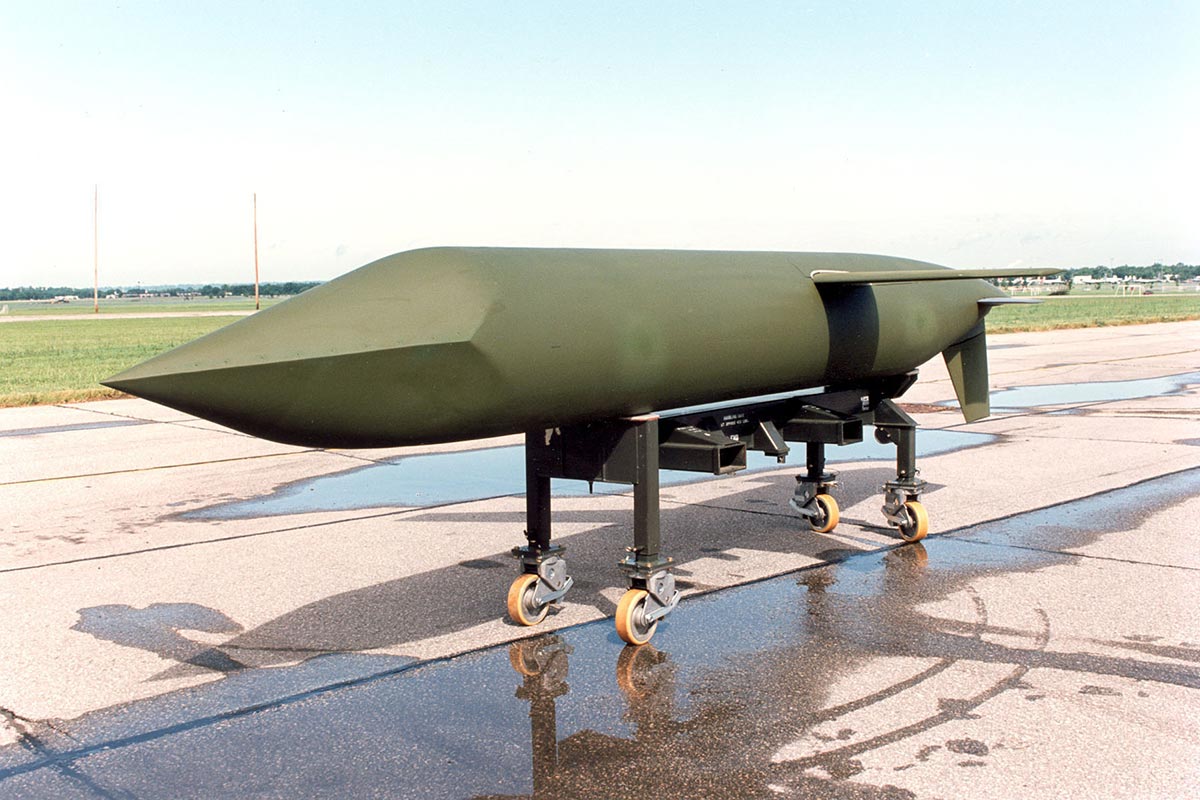
Contractor: Raytheon Missile Systems
Power Plant: Williams International Corp. F-112-WR-100 turbofan engine
Thrust: 700+ lbs
Length: 20 ft, 10 in
Weight: 3,500 pounds
Diameter: 29 in
Wingspan: 10 ft, 2 in
Range: 2,000+ miles
Guidance System: Inertial navigation with terrain contour matching and laser Doppler velocimeter updates
Warhead: Nuclear capable
The AGM-129A advanced cruise missile is a stealth, nuclear-capable cruise missile used exclusively by U.S. Air Force B-52H Stratofortress strategic bombers.
The AGM-129A is a subsonic, turbofan-powered, air-launched cruise missile. It is harder to detect, and has greater range and accuracy than the AGM-86 air-launched cruise missile. The ACM achieves maximum range through its highly efficient engine, aerodynamics and fuel loading. B-52H bombers can carry up to six AGM-129A missiles on each of two external pylons for a total of 12 per aircraft. When the threat is deep and heavily defended, the AGM-129 delivers the proven effectiveness of a cruise missile enhanced by stealth technology. Launched in quantities against enemy targets, the ACM's difficulty to detect, flight characteristics and range result in high probability that enemy targets will be eliminated.
The AGM-129A's external shape is optimized for low observables characteristics and includes forward swept wings and control surfaces, a flush air intake and a flat exhaust. These, combined with radar-absorbing material and several other features, result in a missile that is virtually impossible to detect on radar.
The AGM-129A offers improved flexibility in target selection over other cruise missiles. Missiles are guided using a combination of inertial navigation and terrain contour matching enhanced with highly accurate speed updates provided by a laser Doppler velocimeter. These, combined with small size, low-altitude flight capability and a highly efficient fuel control system, give the United States a lethal deterrent capability well into the 21st century.
In 1982 the Air Force began studies for a new cruise missile with stealth characteristics after it became clear that the AGM-86B would soon be too easy to detect by future air defense systems. In 1983 General Dynamics was awarded a contract to develop the new AGM-129A ACM. The first test missile flew in 1985; the first missiles were delivered to the Air Force in mid-1990.
Plans called for an initial production of approximately 1,500 missiles. The end of the Cold War and subsequent budget cuts led the Air Force to cease production after 460 missiles, with the final delivery in 1993. Several corporate changes during production resulted in Raytheon Missile Systems as the final production firm.
Equipment Categories
- Army Equipment
- Navy Equipment
- Air Force Equipment
- Marine Corps Equipment
- Coast Guard Equipment
- Military Aircraft
- Military Vehicles
- Personal Equipment
- Ships and Submarines
- Special Operations Equipment
Select Service
- National Guard
Latest Equipment Videos
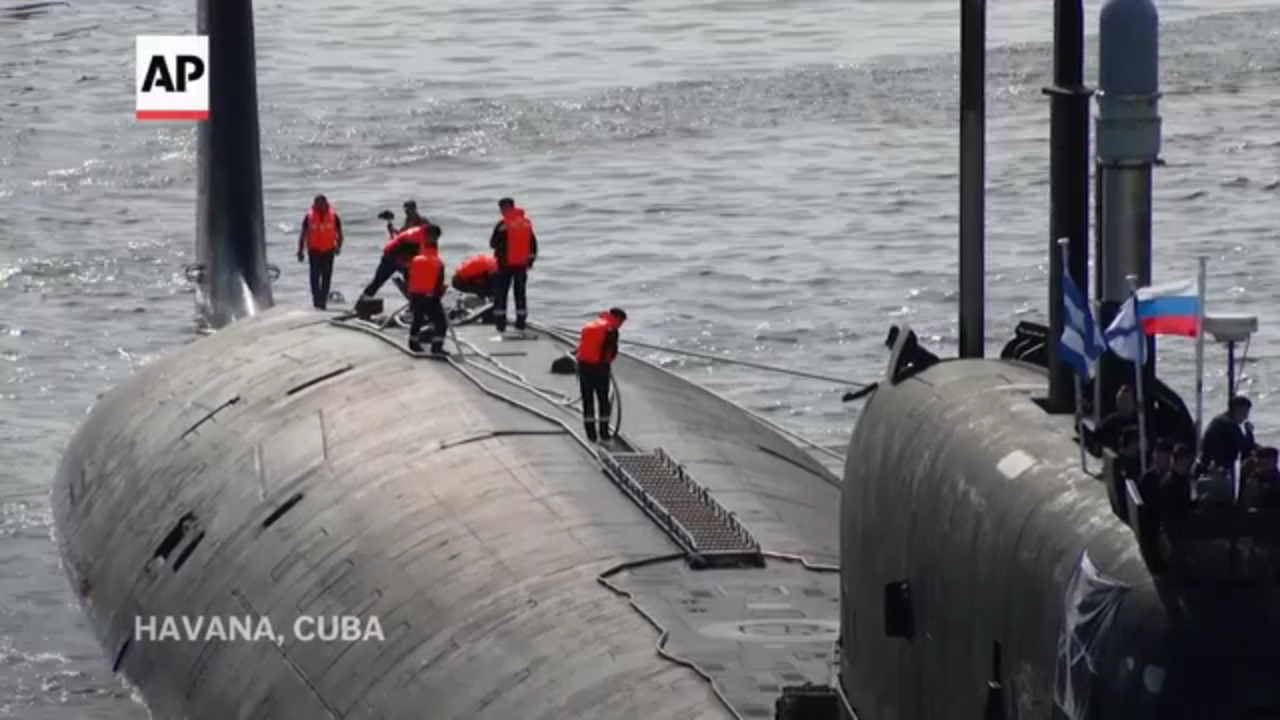
Russian nuclear-powered submarine Kazan left the bay of Havana on Monday followed by the Frigate Admiral Gorshkov ahead of...

Officials from Fort Campbell are hoping the black boxes onboard two Black Hawk helicopters will give insight into what...
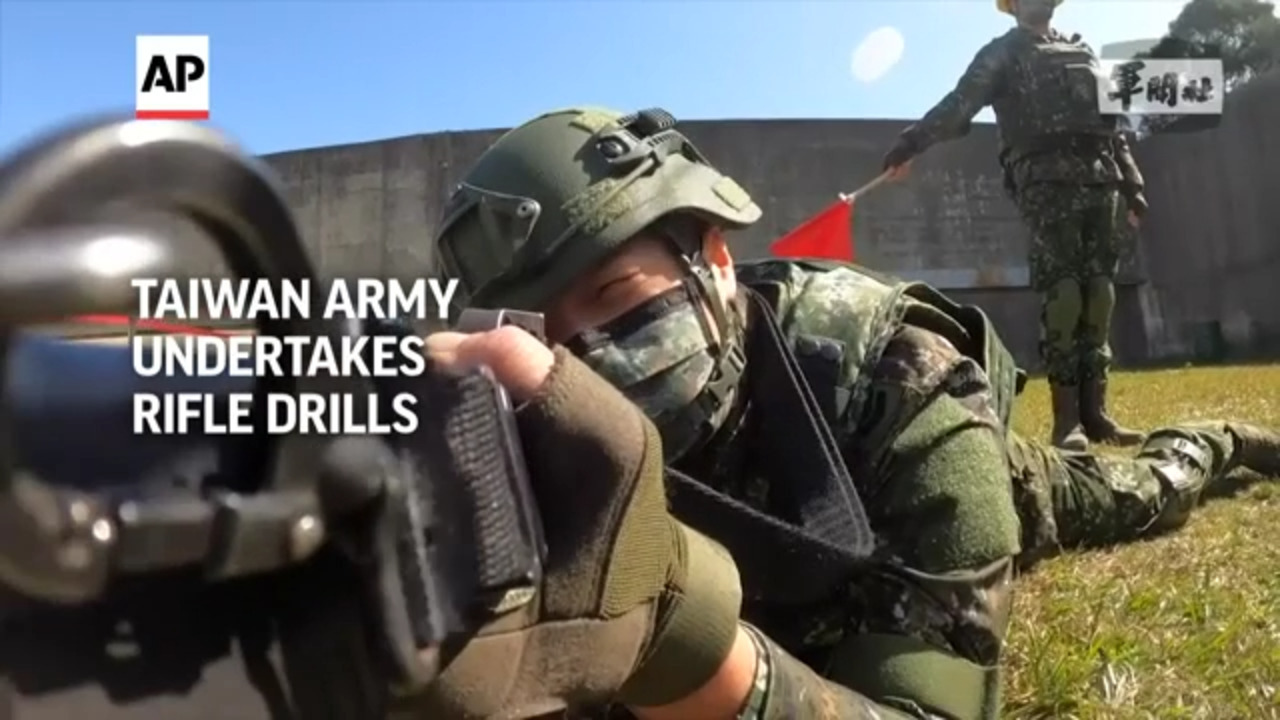
Taiwan’s Army demonstrated a new rifle training program Tuesday that is tailored to the needs of each local solider...

Boeing on Monday hosted a ribbon cutting for a new production area at NASA's Michoud Assembly Facility in New...

Video from the U.S. Coast Guard shows a Miami-based aircrew in a MH-65 Dolphin helicopter rescue four people, a...
Military Technology
- Flaw in Osprey Gears Was Known a Decade Prior to Deadly Japan Crash, Internal Report Shows
- Marine Corps Lays Out Plan for Harrier Crews as Stalwart Aircraft Flies into Sunset
- Soldiers Hit with More Problems Accessing Education Benefits Amid Fall Enrollment Deadlines
- Army Advocates Use of Generative Artificial Intelligence by Soldiers as Other Services Are Hesitant
Acquisition News
- Camp Pendleton Marines Take New Amphibious Vehicle on First Deployment After Early Training Issues
- NASA Chooses SpaceX Vehicle to Deorbit ISS as Crews Take Cover from Near Collision
- After Deadly Crashes, New 'Leading Theory' on Osprey Issues Points to Sprag Clutches
Guns & Gear
- The Best Deals on Shooting Gear on Amazon Right Now
- The Best Tactical Gear Deals on Amazon Right Now
- The Best Amazon Holiday Deals for Service Members, Veterans and Their Families
- The Best Military Watch Deals on Amazon Right Now
Latest Equipment News

The revelations about the history of the gear problems come as family members from the Japan crash, as well as families of...

The Harrier -- once the bleeding edge of Marine Corps aviation with its vertical takeoff and landing capability -- is set to...

Biden boarded the Sikorsky-made helicopter after arriving on Air Force One in Chicago where he is speak at the Democratic...

Boonie hats are round, wide-brimmed sun hats worn by troops in particularly hot or tropical climates, such as the jungles of...
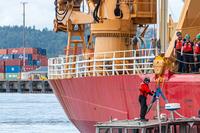
While the Coast Guard previously had said it favored Juneau as the ship's home station, officials said as recently as June...
- svg]:fill-accent-900">
The Saga Of The AGM-129 Cruise Missile That Was Basically A Stealth Jet Designed Upside Down
By Tyler Rogoway
Updated on Dec 5, 2019 8:20 AM EST
18 minute read
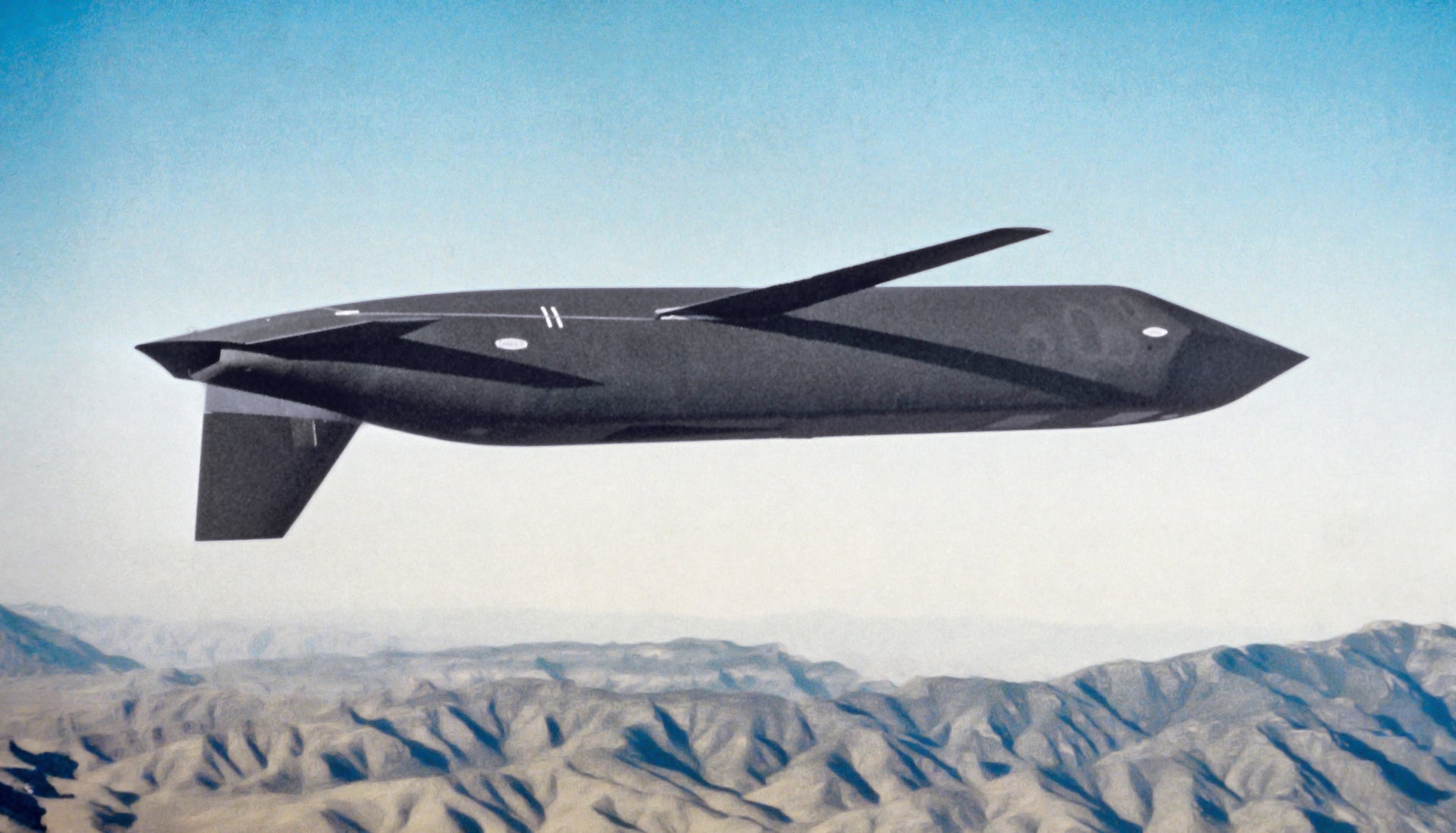
Most people would be surprised to hear that the most advanced nuclear-tipped cruise missile ever put into operation was retired from service while its predecessor, a less survivable missile it was supposed to replace, soldiers on in U.S. Air Force service to this very day. This topsy-turvy reality is somewhat metaphorical of General Dynamics’ AGM-129 Advanced Cruise Missile (ACM) itself. In fact, the AGM-129 could be considered the second stealth aircraft to ever enter production, because that is what it really was, albeit one that was designed upside down, and for good reason.
The origins of the ACM are fairly straightforward. The AGM-86B Air-Launched Cruise Missile (ALCM) entered service in the early 1980s. When it was being designed, and while the non-production AGM-86A was undergoing initial trials, the best way to deliver a nuclear warhead deep inside Soviet airspace by an air-breathing platform was via low-altitude penetration . The AGM-86 was designed exactly for that, to punch through at treetop level using terrain contour matching , terrain-following radar, and inertial navigation to get close enough to a target that the W80 nuclear warhead onboard could do its job successfully.

Later on, the AGM-86C and D would integrate GPS to deliver pinpoint conventional strikes. You can read all about the AGM-86C/D’s capabilities in this recent piece of ours , but the nuclear-armed version of the era had no such accuracy. Regardless, survivability against quickly evolving Soviet air defenses was the most pressing requirement in the Air Force’s air-launched cruise missile portfolio as the 1970s gave way to the 1980s.

The AGM-86B had a few stealthy characteristics, but it was far from a true low observable design. Just as it came into service, the Air Force realized that the days when being able to beat air defenses via low-flying alone were coming to an end. Airborne early warning and control aircraft and advanced fire control radars with look-down-shoot-down capabilities, like those on Russia’s 4th generation fighter and interceptor fleets (Su-27 and MiG-31, specifically), would decrease the effectiveness of nap-of-the-earth flying tactics. Something far more survivable was needed, and fast.

Out of a handful of DARPA initiatives and studies dubbed TEAL DAWN that explored future cruise missile technologies and long-range bomber strategies, it was concluded that the new stealth bomber then in development alone wouldn’t be survivable against the densest Soviet air defenses. Long-range and survivable standoff weapons would be needed in part to mitigate those defenses. Two requirements were established—one stealthy missile that could travel around 1,500 miles or more and another that could travel over 5,000 miles. The latter clearly invalidated much of the need for a stealth bomber in the first place and it was thought that at least a decade would be needed to develop such a long-range weapon. As a result, it was jettisoned to concentrate on the shorter-ranged stealthy cruise missile requirement that could be fielded quickly and equip the Air Force’s new stealth bomber—at least that’s what they hoped. With this in mind, a competition to build such a weapon was quietly launched.
Lockheed, Boeing, and General Dynamics ended up squaring off in secret for this new contract. Lockheed’s Skunk Works leveraged their work on the F-117 program, which was just spinning up in a very secretive operational state at the time , to produce its F-117-shaped cruise missile, known under the code name SENIOR PROM. The details surrounding Boeing’s design remain unclear. General Dynamics’ design was a bit more of a traditional configuration, but one that was clean-sheet and packed with very stealthy features arranged in unique ways to maximize its effectiveness and efficiency. SENIOR PROM, which was a test program before competing for the Advanced Cruise Missile contract, was very stealthy, but it would have been troublesome fitting it into a bomber’s weapons bay. By 1983, General Dynamics clenched the contract and the AGM-129A Advanced Cruise Missile was officially born.

General Dynamics’ design, which measured nearly 21 feet long and weighed in at 3,700 pounds, was downright wicked looking. A faceted, stiletto-shaped fuselage with a chined, sharp-tip nose area and forward-swept pop-out wings gave it a sinister, almost Klingon-like look. Not just the wings were backward, all the low observable features were oriented towards defeating detection from above , not below. This resulted in an upside-down-looking airframe of sorts.
The vertical stabilizer-rudder pointed down instead of up. It was made up of composite materials, as were the missile’s horizontal forward-swept stabilizers, to remain nearly invisible to the most threatening radar bands. The vertical stabilizer was also offset to the left side of the fuselage’s centerline.

That gas from the missile’s two-dimensional exhaust aperture was blown over a platypus-like defuser structure that shielded its signature from, you guessed it, above, instead of below. The exhaust was also mixed with cold air to help further attenuate its infrared signature. Soviet infrared search and track (IRST) systems were advancing in capability at the time and included on all of Russia’s 4th generation fighter/interceptor designs, so infrared signature reduction was weighted heavily alongside radar cross-section reduction during the competition that led to the AGM-129.

The low-observable trapezoidal air inlet sat flush on the bottom of the missile instead of the top of it and fed the engine with air through a serpentine duct, thus eliminating any radar return from the engine fan face. Realizing a flush air inlet on something that flies at transonic speeds comes with major design challenges and it’s not like any stealthy air inlet configuration is easy to design or produce , to begin with. Beyond its underlying radar-evading structures , the AGM-129 was also covered with radar absorbent material and coatings and given an olive drab color to blend in with the terrain it would roar over just before sparking off a nuclear apocalypse.
So, if you think the AGM-129 looks like it is flying inverted, that is by very conscious design. Overall, the missile was designed with a particular weight put on stealth from its upper and forward aspects, where it was most vulnerable. From directly to its side, its radar signature was reduced, but more visible than from other angles. This was deemed a non-issue because the pulse-doppler radars that could threaten it from above are unable to detect low-flying targets hiding in ground clutter while flying at perpendicular angles to the radar antenna as they remain inside the radar’s “doppler notch.” You can read more about this phenomenon and the tactics associated with it here.
Navigation was also innovative. The AGM-129 introduced a laser doppler velocimeter into its navigational suite, which, like the AGM-86, also included inertial navigation and terrain contour matching. This gave it substantially better accuracy over long distances than the AGM-86B, which was designed less than a decade before it.
It also included laser detection and ranging system (LADAR) to aid in low-altitude flight, which further allowed it to fine-tune its endgame attack run down to as accurate as 90 feet according to stated metrics, although the system likely became even more accurate as it matured. Considering it still packed the same W80 variable yield warhead (5kt-150kt) as the AGM-86B, its better accuracy substantially increased its effectiveness, especially against reinforced targets or those that are partially shielded by terrain.
LADAR, as opposed to radar, also allowed the AGM-129 to remain electromagnetically silent, giving off no radio frequency energy when it was most vulnerable and thus making it even harder to detect. There were some tradeoffs though, LADAR could have trouble receiving data against certain surfaces, such as those that were extremely reflective or highly light absorbent. Still, the system was extremely effective and because the missile was so stealthy, it could fly at higher altitudes and in most cases still survive to make it to its target if need be.

Still, the system was not perfect. During one test over Dugway Proving Ground in 1997, an AGM-129 was flying so low it impacted some trailers belonging to an observatory. Nobody was hurt in the incident and the missile had been flying for three and a half hours before the accident. It turns out the mission planners had no idea the trailers were there and how the missile got so low was unclear to begin with.
The missile was fast, traveling at just under the speed of sound, and it also packed a very long range. It used a far more fuel-efficient engine, the Williams International F112-WR-100 turbofan, than the one found on the AGM-86, which gave it significantly greater range while retaining similar dimensions and the same payload. Officially, ACM could reach out 2,000 miles to its target , but it seems clear that its real range was actually significantly further, especially when flying a more efficient flight profile during more benign portions of its trip to its target area. As noted earlier, the missile’s high degree of stealth meant that it could climb to more efficient altitudes during certain phases of flight and still have a high chance of surviving to complete its horrific task.
Another interesting component of the AGM-129 was its computer system. From how it has been explained to me it used basically one central processor and computing system to run the vast majority of the missile’s functions. For early 1980s military technology, this is an amazing feat. Basically, the computer system and the system designed to used it on the missile was absolutely cutting-edge for its time.

It can’t be stressed enough how advanced the ACM was for its time. It had many elements that hadn’t yet emerged from the classified manned aircraft realm, but was an autonomous system meant to fly thousands of miles to its target without aid and to be built by the hundreds. It was truly a highly sensitive modern marvel of its era.
The first flight test of an AGM-129 occurred in July of 1985, with the first production missiles being delivered two years later, in 1987. It was that year when the program became public, as well. In that sense, it was the first disclosure of a stealth flying machine ever. Still, the program struggled early in its production run. There were technological issues that popped up in flight testing, but the major problems were with building the advanced missiles themselves. Remember, at the time of its first deliveries, no stealth aircraft had even been acknowledged by the Air Force. This wouldn’t occur until two years later when the F-117 was officially disclosed to the public. So, the technologies used in its manufacturing were absolutely cutting-edge in nature.
The missile’s very aggressive concurrent testing and production schedule concept and major labor issues with the International Association of Machinists began to cripple the program and it quickly became a pariah on Capitol Hill and in certain parts of the Pentagon. By the end of the decade, the AGM-129 was being declared a fiasco. Things got so bad with quality control issues that production was halted between 1989 and 1991.

Of course, the timing of this setback couldn’t have been worse. The Cold War was ending and the defense budget was set to snap back hard, especially in terms of strategic weaponry. In addition, the B-2 wouldn’t fly until 1989 and still would have a long developmental road ahead of it. The B-1B was also having its own troubles and the missile was never designed to fit in its weapons bays , it was too long, and eventually, the B-1B would lose its nuclear role altogether. So, the weapon that was procured at least in part to be paired with the stealth bomber would be relegated to the B-52.
The confluence of these factors, as well as the START treaty which limited these types of weapons, resulted in a drastic reduction of the programmed buy. The nearly 1,500 missiles needed to replace the AGM-86B in full was slashed down to less than half that, and eventually to a final number of just 460 missiles. Unit cost soared partially as a result of the curtailed order, with each missile costing roughly $4.3 million in 1992 dollars. This is extremely expensive for a cruise missile even by today’s standards. A decade earlier, the AGM-86Bs cost around $1.3 million each. The ACM had truly entered a Pentagon budgetary ‘death spiral’ alongside the plane that was supposed to carry it, the B-2.

Still, they were the most advanced cruise missiles in the world and the truncated force of 460 missiles soldiered on over the next two decades, exclusively equipping the B-52 force. A single B-52 could carry 20 of the missiles at one time. Six on each wing pylon and eight in the jet’s cavernous weapons bay on a rotary launcher.
Two other AGM-129 variants were proposed, but never came to fruition. The AGM-129B was a shadowy initiative to equip a revised design with an axial-flow jet engine, new software, and a different nuclear warhead to take on a specialized role that remains classified. This could have been a GPS-equipped, imaging infrared, or otherwise more precise upgrade of the weapon that would also be equipped with a penetrating nuclear warhead of a lower yield to take on heavily fortified bunkers and more hardened structures. Then again, maybe it was something more exotic, we just don’t know for absolute certain.

The other proposed variant was a conventional land attack model similar to the AGM-86C/D Conventional Air-Launched Cruise Missiles (CALCM), but far more survivable and with a lot longer reach. GPS would have been necessary for this weapon, just like it was for its CALCM progenitor. An imaging infrared seeker with imaging matching could have been injected into the design for even better accuracy. In retrospect, this would have been a relatively amazing weapon.
The ACMs that were built may have received a GPS upgrade sometime during the decade and a half or so that followed their introduction into service in 1990, although it remains unclear if this actually happened. It would have given the missiles pinpoint accuracy, but GPS connectivity would not be assured during a nuclear war and it may have been cost-prohibitive to integrate a GPS antenna onto the ACM’s stealth airframe. If the upgrade did happen, it would have likely occurred when the missiles were put through a Service Life Extension Program (SLEP) in the early 2000s that would allow them to serve until 2030 and possibly beyond.
Regardless of this life extension program, in 2007, the 17th year of the AGM-129’s operational service, it was decided that the entire ACM force would be drawn down and eliminated from service by the end of 2012. A number of factors contributed to this decision, the first being the post 9/11 focus on counter-insurgency operations instead of preparing for peer state conflicts. The U.S. had two raging wars on its hands that were anything but cheap, and the Russian bear remained largely dormant at the time, while China was just on precipice its economic, geopolitical, and technological rise. The AGM-129 program, with its relatively small fleet made up of super high-tech 1980s technology, meant that sustaining the missiles was far from a cheap or easy task. The AGM-86B, although much less survivable, checked a box for much less money and had commonality with its conventionally armed cousin, the AGM-86C/D, which helped significantly in terms of sustainment scalability.
Beyond fiscal matters, the Strategic Offensive Reductions Treaty (SORT) with Russia also meant more warheads would be pulled off the front lines. So, the Air Force moved forward with not just retiring the AGM-129, but destroying the fleet, a task that was completed as planned by the end of 2012.
During its drawdown period, one highly publicized and unfortunate event occurred with what were historically very shy missiles. On August 30th, 2007 a “Bent Spear” incident occurred with a package of 12 ACMs. A B-52H was set to ferry unarmed ACMs from Minot AFB in North Dakota to Barksdale AFB in Louisiana. The missiles were to be decommissioned at Barksdale, so the mission itself wasn’t necessarily out of the ordinary. What was not normal is that six of the missiles were actually carrying their W-80 thermonuclear warheads.
The nuclear-armed B-52 sat overnight without a proper security detail and other precautions until the crew showed up for the mission the next day. During pre-flight checks, the crew did not inspect both pylons loaded with missiles. They only inspected the one that held six unarmed ACMs, but logged that both pylons full of missiles were indeed checked and that they were unarmed. The crews then flew across the Midwest not knowing they were carrying six nuclear warheads.

After arriving at Barksdale, the jet sat for another eight hours without standard precautions associated with nuclear-armed aircraft. It was nearly a day and a half after the Minot AFB personnel blew off normal procedures and loaded the hot ACMs on the B-52 that the fact that the plane was actually carrying live warheads was discovered. The incident was the first of its kind in four decades and sent shockwaves through the Air Force and the Pentagon. A subsequent investigation showed horrible disregard for critical nuclear weapons handling protocols and everyone from four unit commanders down to those directly involved were heavily disciplined or removed from duty. All nuclear weapons handling was suspended at Minot AFB. It also resulted in a new set of procedures that were designed to make sure such a breakdown in procedures doesn’t happen again.
It was a sad end to the troubled development and career of the world’s first stealth cruise missile.

In retrospect, the decision not just to retire, but fully destroy the AGM-129 cadre seems like a very poor one. Today, the Air Force is working on developing a new stealthy long-range nuclear-tipped cruise missile, the Long-Range Stand-Off (LRSO) weapon, a program that will cost tens of billions of dollars and won’t produce an operational missile until at least 2030. Raytheon, which owns the AGM-129 design after it bought Hughes Missile Systems, which bought General Dynamics’ missile portfolio prior, is competing with Lockheed for the LRSO contract. In the meantime, the AGM-86B is supposed to remain a viable deterrent even in an era of ever more capable highly integrated air defense systems, ones that now rely on look-down-shoot-down sensors more than they did 35 years ago and that are far more advanced in general than what existed when ACM was conceived. This begs the question, is the AGM-86B really a survivable deterrent at all? The true answer, that we will never officially get, is probably less comforting than we may want to hear.
The truth is, the AGM-129 was way ahead of its time. Today, there are numerous stealthy cruise missiles in production or will be in production soon and they are becoming an extremely sought-after item. The USAF can’t get enough of Lockheed’s JASSM family of missiles , which continues to rapidly grow in capability, while the Navy is procuring the anti-ship LRASM cousin of JASSM, the stealthy Naval Strike Missile , and a powered version of the JSOW. Multiple foreign militaries have their own stealthy cruise missiles , as well. But these are conventionally armed weapons. It will be at least another decade until a nuclear-armed stealth cruise missile hits the USAF’s inventory again. That weapon, the LRSO, will be in many ways the son of AGM-129 and from what we are hearing, it will be absolutely loaded with the latest and greatest technology that will allow it to survive in the most inhospitable of combat environments. It is also meant to equip the USAF’s new stealth bomber, the B-21 Raider.
Somehow this all sounds eerily familiar, doesn’t it?
Contact the author: [email protected]
SIGN UP FOR OUR NEWSLETTERS
Sign up to receive our newsletter every week.
By signing up you agree to our Terms of Service and Privacy Policy.
Let Your Curiosity Soar
Agm-129a advanced cruise missile.
The AGM-129A was a subsonic, turbofan-powered, air-launched cruise missile. It was harder to detect and had greater range and accuracy than the AGM-86 Air-Launched Cruise Missile (ALCM). B-52 bombers could carry up to six AGM-129A missiles on each of two external pylons for a total of 12 per aircraft . Launched in quantities against enemy targets, the ACM’s difficulty to detect, flight characteristics and range resulted in the high probability that enemy targets would be eliminated. The AGM-129A saw service from 1990 to 2002.
Additional Exhibits
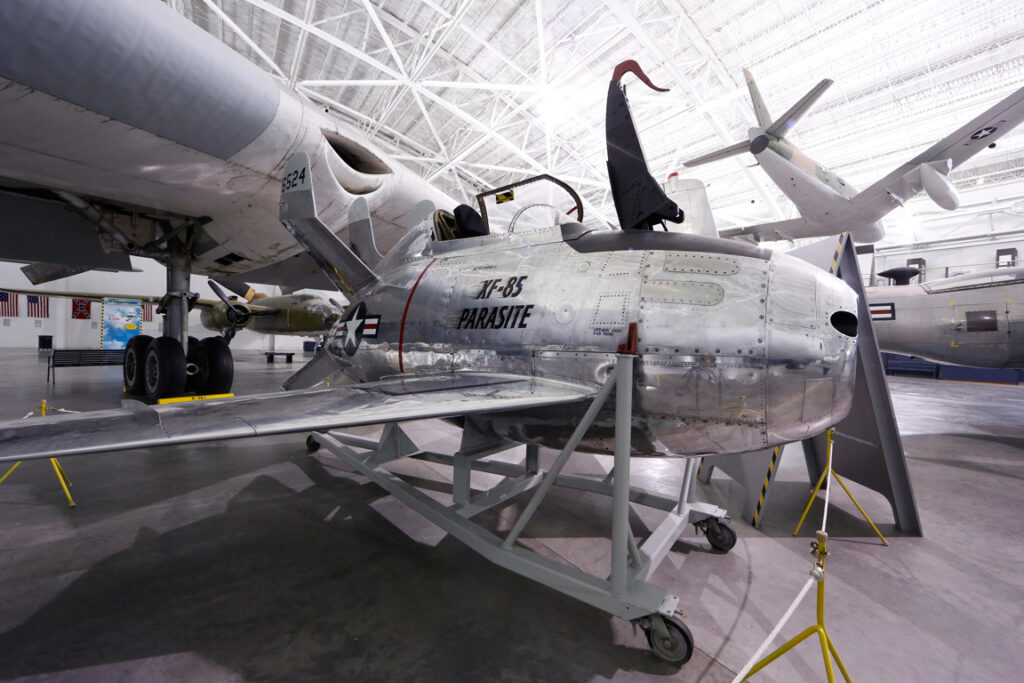
XF-85 “Goblin”
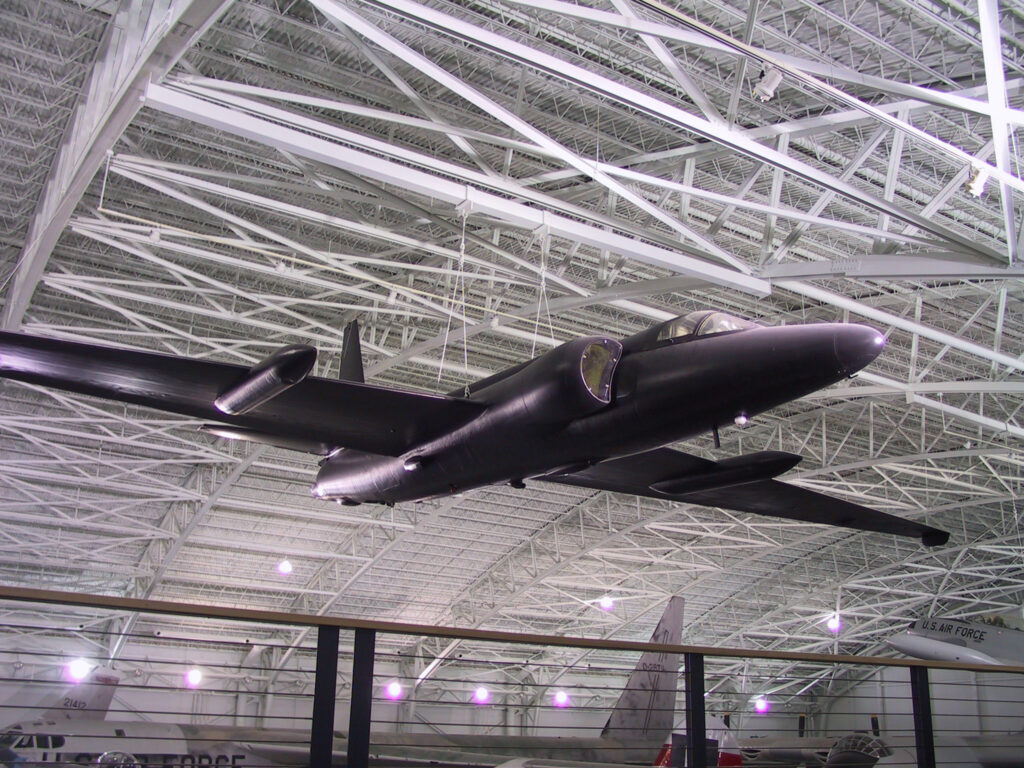
U-2C “Dragon Lady”
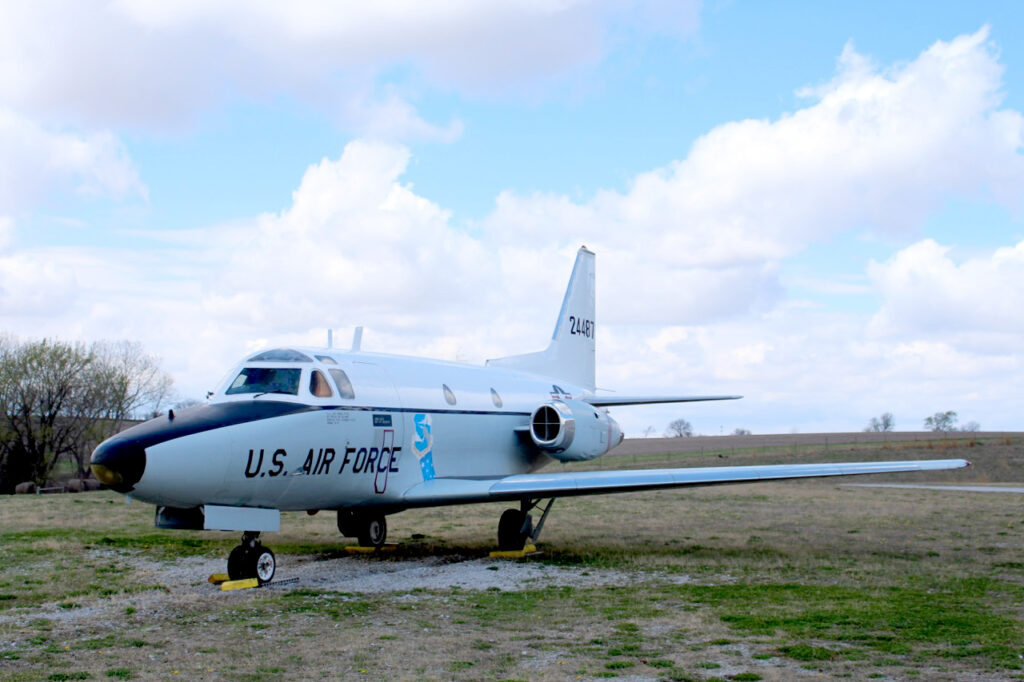
T-39A “Sabreliner”
(e.g. [email protected])
Remember me
Forgot Password?

- SECRETARY OF DEFENSE LLOYD J. AUSTIN III
- Combatant Commands
- Holiday Greetings Map
- Taking Care of Our People
- Focus on the Indo-Pacific
- Support for Ukraine
- Value of Service
- Face of Defense
- Science and Technology
- Publications
- Storytellers
- Media Awards
- Hometown Heroes
- Create Request
- Media Press Kit

- DVIDS DIRECT
Hometown News
Media requests, about dvids.
- Privacy & Security
- Copyright Information
- Accessibility Information
- Customer Service
Tinker Celebrates 75 Years: Raytheon AGM-129A ‘ACM’ missile profile

Photo By Greg L. Davis | General Dynamics AGM-129 Advance Cruise Missile on display with wings out as if... ... read more read more
Photo By Greg L. Davis | General Dynamics AGM-129 Advance Cruise Missile on display with wings out as if in-flight in the Charles B. Hall Memorial Air Park on Feb. 16, 2017, Tinker Air Force Base, Oklahoma. Tinker AFB maintains not only aircraft, but also cruise missiles and their components. (U.S. Air Force photo/Greg L. Davis) see less | View Image Page
OKLAHOMA CITY, OKLAHOMA, UNITED STATES
Story by greg l. davis , 72nd air base wing.
Tinker AFB, Okla.--The Convair/General Dynamics/Raytheon AGM-129A Advanced Cruise Missile was an air-launched, high-subsonic capable missile developed for employment with Air Force manned bomber programs. The ACM was designed to supplement AGM-86B Air-Launched Cruise Missiles already in use and first flew in 1985. Initial deliveries of AGM-129A ACMs to Air Force stocks took place by mid-1990. The last of 460 examples was delivered in 1993, marking a relatively short production run for a weapon system of this type. Originally slated for use by both the B-52G/H Stratofortress and B-1B Lancer, the missile would only be fielded with the B-52 fleet at Barksdale Air Force Base, Louisiana and Minot AFB, North Dakota. Each B-52 was capable of carrying six ACMs on two underwing pylons for a total of twelve AGM-129As per aircraft. Tinker’s role with the AGM-129A came through engine maintenance and sustainment operations. The Williams International F112-WR-100 turbofan has a high thrust to weight ratio and produced over 700 pounds of thrust. Organic sustainment operations for the F112 began on July 23, 1991, when a depot maintenance line was activated within the Oklahoma City Air Logistics Center. During the missiles service life there were 552 inputs to the F112 line between 1991 and 2002, according to Tinker history documents. The ACM was the Air Force’s first missile to incorporate stealth design elements such as angular surfaces, radar-absorbent material, a flush-mounted jet intake and flat exhaust hidden near the tail. These features reduced the radar signature to make the missile hard to detect by enemy radar and therefore hard to defend against by the associated air-defense systems. Forward-swept, switchblade like wings were deployed from their stowed (carry) position within seconds after release by the B-52. An incredible range of over 2,000 miles was possible through the use of precision guidance inertial navigation and terrain contour matching systems, along with a highly efficient engine and associated fuel management system. Each missile was 20 feet, 10 inches long, had a 10 foot wingspan and weighed more than 3,500 pounds. The ACM was equipped with a W80-1 nuclear warhead with 5-150 kiloton yield. During its service life the ACM-129A was one of two nuclear capable air-launched missiles in use by the Air Force, but the only with stealth characteristics. The expected service-life of 2030 was abruptly cut short for the ACM when funding was removed from the fiscal 2008 budget to meet reduction of nuclear warhead treaty agreements made with Russia in the previous years. Manufacturer: Convair/General Dynamics/Raytheon Missile type: AGM-129A Nickname: ACM Power plant: Williams International F112-WR-100 turbofan engine In-service dates: 1990-2008 Number produced: 460 Tinker connection: Engine maintenance and sustainment
PUBLIC DOMAIN
This work, Tinker Celebrates 75 Years: Raytheon AGM-129A ‘ACM’ missile profile , by Greg L. Davis , identified by DVIDS , must comply with the restrictions shown on https://www.dvidshub.net/about/copyright .
CONNECTED MEDIA

MORE LIKE THIS
Controlled vocabulary keywords.
No keywords found.
- Register/Login to Download
DVIDS Control Center
- 404-282-1450
- [email protected]
Web Support
- [email protected]
- 1-888-743-4662
- Links Disclaimer
- No FEAR Act
- Small Business Act
- Open Government
- Strategic Plan
- Inspector General
- Sexual Assault Prevention
- DVI Records Schedule
- DVI Executive Summary
- Section 3103

Unraveling the AGM-129 ACM: A Comprehensive Guide
- May 3, 2024
The AGM-129 Advanced Cruise Missile (ACM) stands as a pinnacle of precision weaponry, embodying cutting-edge technology and unparalleled capabilities in modern warfare. Developed to redefine strategic operations, the AGM-129 ACM represents a formidable fusion of innovation and strategic foresight – a game-changer in the realm of cruise missiles.
Unveiling a realm of tactical sophistication, this article delves into the genesis, specifications, operational nuances, and comparative insights of the AGM-129 ACM, shedding light on its pivotal role in shaping military strategies and international dynamics.
Table of Contents
Development of the AGM-129 ACM
The development of the AGM-129 ACM (cruise missile) stemmed from the United States Air Force’s need for a long-range precision weapon system. Initiated in the late 1970s, the project aimed to create a cruise missile with advanced capabilities to enhance strategic strike capabilities.
With a focus on stealth and accuracy, the AGM-129 ACM was designed to penetrate enemy defenses and deliver its payload with precision. Incorporating innovative technology, such as advanced guidance systems and stealth features, the development process faced challenges but ultimately led to the successful creation of a sophisticated weapon system.
Through rigorous testing and refinements, the AGM-129 ACM evolved into a formidable weapon in the U.S. Air Force’s arsenal, showcasing advancements in missile technology and strategic capabilities. The development phase marked a significant advancement in long-range precision strike capabilities, solidifying the missile’s role in modern warfare scenarios.
Specifications of the AGM-129 ACM
The AGM-129 ACM is a subsonic air-launched cruise missile used primarily by the United States Air Force. Featuring a length of 4.5 meters and a wingspan of 2.7 meters, this missile boasts a formidable range exceeding 2,000 kilometers. Its 2-stage jet engine propels it at speeds capable of penetrating enemy defenses effectively.
Equipped with a W80-1 variable-yield nuclear warhead and advanced guidance systems, the AGM-129 ACM ensures precise targeting capabilities for strategic strikes. Its low-altitude flight profile enhances stealth capabilities, allowing it to evade enemy radar detection and interception measures. Additionally, the missile’s sophisticated navigational systems provide unparalleled accuracy in hitting designated targets.
The AGM-129 ACM’s robust design incorporates stealth features to minimize its radar cross-section and enhance survivability during missions. With a cruise speed of approximately 800 km/h, this cruise missile can deliver its payload with precision and effectiveness. Overall, the specifications of the AGM-129 ACM underscore its status as a critical asset in modern warfare, combining range, accuracy, and stealth for strategic operational success.
Operational Deployment
The AGM-129 ACM’s Operational Deployment involves strategic planning and execution to ensure precision strikes and effective target engagement. This cruise missile is meticulously deployed in various combat scenarios, showcasing its versatility and lethal capabilities on the battlefield. Below are key aspects highlighting the significance of its operational deployment:
Target Acquisition: AGM-129 ACM’s deployment prioritizes precise target acquisition, enabling strategic strikes on high-value enemy assets with minimal collateral damage.
Stealth Capabilities: Its stealth technology allows for covert operations, evading enemy radar detection and enhancing mission success rates through surprise attacks.
Adaptive Mission Profiles: The AGM-129 ACM’s operational deployment includes adaptable mission profiles, catering to diverse combat environments and ensuring optimal mission outcomes.
Synchronize Attack Strategies: Coordination with other military assets enhances the AGM-129 ACM’s operational deployment, synergizing efforts for synchronized attacks and achieving strategic objectives efficiently.
Comparison with Other Cruise Missiles
When comparing the AGM-129 ACM to other cruise missiles, its standout feature lies in its exceptional performance contrasts and tactical advantages. In terms of precision and range, the AGM-129 ACM showcases superior accuracy and an extended operational reach, making it a prominent choice for strategic missions requiring pinpoint targeting capabilities.
Additionally, the AGM-129 ACM exhibits distinct tactical advantages in terms of stealth capabilities and mission flexibility compared to other cruise missiles. Its low observability and advanced guidance systems enable it to operate effectively in contested environments while offering diverse mission profiles, enhancing its overall utility in modern warfare scenarios.
Moreover, the AGM-129 ACM’s innovative design and advanced technologies have set it apart from traditional cruise missiles, contributing to its unique capabilities and operational effectiveness on the battlefield. These advancements have further reinforced its position as a critical asset in military arsenals, providing a significant edge in precision strike capabilities and strategic deployments.
Performance Contrasts
The AGM-129 ACM showcases notable performance contrasts when compared to other cruise missiles in its class. These distinctions shape its effectiveness on the battlefield and strategic utility. Key points of differentiation include:
- Accuracy: The AGM-129 ACM demonstrates unparalleled precision in target acquisition and engagement, enhancing its overall effectiveness in achieving mission objectives.
- Range: With an extended operational range, the AGM-129 ACM surpasses many counterparts, enabling it to engage targets from a greater distance with heightened accuracy.
- Stealth Capabilities: Its advanced stealth features provide enhanced survivability by reducing detection levels, making it a formidable opponent in modern warfare scenarios.
- Payload Capacity: Despite advancements in technology, the AGM-129 ACM maintains a substantial payload capacity, allowing for versatile mission configurations and strategic flexibility.
Tactical Advantages
The AGM-129 ACM boasts tactical advantages that contribute to its effectiveness on the battlefield. One key advantage is its extended range capability, allowing for precise strikes on targets that may be situated at a considerable distance. This feature enhances operational flexibility and increases the reach of military forces during missions where strategic placement is crucial.
Moreover, the AGM-129 ACM is equipped with advanced guidance systems, enabling enhanced accuracy and target acquisition. This heightened precision minimizes collateral damage and maximizes the probability of mission success. The missile’s ability to navigate complex environments and adapt its trajectory in real-time adds a layer of sophistication that sets it apart from conventional weaponry.
Additionally, the AGM-129 ACM exhibits stealth characteristics that reduce its radar signature, making it more challenging for opposing forces to detect and intercept. This element of surprise enhances its survivability and ensures a higher likelihood of mission accomplishment. The combination of long-range precision, advanced guidance systems, and stealth capabilities grants the AGM-129 ACM a strategic edge in modern warfare scenarios.
AGM-129 ACM Development Challenges
The development of the AGM-129 ACM posed significant challenges, primarily in overcoming design obstacles and technical complexities. Engineers and military experts encountered hurdles in optimizing the missile’s range, accuracy, and stealth features while ensuring reliability under various operational conditions. These challenges demanded innovative solutions to enhance the missile’s performance capabilities and maintain its effectiveness in modern combat scenarios.
One key challenge in the development of the AGM-129 ACM was reconciling the need for advanced technological features with the imperative of cost-effectiveness. Balancing cutting-edge specifications with affordability required meticulous planning and testing to achieve a weapon system that meets stringent military standards while remaining feasible for widespread deployment. Additionally, streamlining the production process and ensuring supply chain efficiency were essential considerations in mitigating development challenges and ensuring the missile’s readiness for operational use.
Moreover, the evolution of defense technologies and rival capabilities presented ongoing challenges for the AGM-129 ACM’s development. The need to adapt to emerging threats, counter adversarial defenses, and stay ahead in the arms race necessitated continuous advancements and upgrades. Overcoming these challenges required consistent investment in research and development, collaboration with industry partners, and rigorous testing to address vulnerabilities and maintain the missile’s edge in modern warfare environments.
In summary, the development challenges of the AGM-129 ACM underscore the intricate nature of designing and perfecting a high-precision cruise missile for strategic military use. By tackling issues related to design, cost, technological advancements, and evolving threats, developers of the AGM-129 ACM have demonstrated a commitment to enhancing national defense capabilities and staying at the forefront of cruise missile innovation.
Design Obstacles
The development of the AGM-129 ACM faced significant design obstacles that required innovative solutions. One of the primary challenges was ensuring the missile’s stealth capabilities while maintaining maneuverability and range. Balancing these conflicting design requirements demanded cutting-edge aerodynamic engineering and materials technology.
Moreover, integrating advanced guidance systems into the missile posed a complex design hurdle. Precision targeting and autonomous navigation capabilities had to be seamlessly incorporated without compromising the overall performance of the AGM-129 ACM. This necessitated meticulous system integration and rigorous testing to ensure operational effectiveness.
Additionally, the miniaturization of components and systems to fit within the missile’s limited space presented a significant design obstacle. Engineers had to optimize every aspect of the AGM-129 ACM’s internal structure to accommodate advanced avionics, propulsion systems, and warhead while meeting strict size and weight constraints.
Addressing these design obstacles required a multidisciplinary approach, with experts in aerodynamics, materials science, electronics, and propulsion collaborating to overcome technical challenges. The successful resolution of these design obstacles was crucial in achieving the AGM-129 ACM’s status as a highly advanced and versatile cruise missile in modern military arsenals.
Innovations Overcome
Innovations Overcome: The development of the AGM-129 ACM posed significant challenges that demanded innovative solutions. One key hurdle was enhancing stealth capabilities without compromising payload capacity. Engineers overcame this by integrating advanced radar-absorbing materials and refined aerodynamic design, ensuring minimal radar detection while maintaining effective warhead delivery.
Additionally, addressing navigation accuracy was crucial for the AGM-129 ACM’s success. To achieve precise target acquisition over long distances, engineers implemented cutting-edge GPS guidance systems and advanced inertial navigation technology. These innovations not only improved overall mission effectiveness but also ensured minimized collateral damage potential, showcasing the missile’s precision strike capabilities.
Moreover, the need for reliable communication systems presented a critical innovation milestone. Overcoming potential signal interference and ensuring secure data transmission were paramount. Engineers integrated encrypted communication protocols and robust anti-jamming technologies, guaranteeing seamless connectivity between the missile and command centers, thereby enhancing operational control and situational awareness during critical missions. These innovations solidified the AGM-129 ACM as a versatile and dependable asset in modern warfare scenarios.
Future Prospects and Upgrades
Future Prospects and Upgrades hold significant importance in the trajectory of the AGM-129 ACM (cruise missile), offering a glimpse into forthcoming advancements. The evolution of technology is poised to enhance the missile’s capabilities, ensuring its competence in modern warfare scenarios. Key aspects to consider regarding the AGM-129 ACM’s future include:
- Integration of advanced guidance systems for improved accuracy and target acquisition.
- Upgrades in propulsion systems to enhance speed and range capabilities.
- Incorporation of stealth technologies to reduce detectability and increase mission success rates.
These prospective upgrades not only underscore the missile’s potential for continued relevance in military operations but also signify its adaptability to meet evolving defense needs. As military strategies evolve, the AGM-129 ACM’s future prospects and upgrades play a pivotal role in shaping its impact on defense mechanisms and international security dynamics.
Enhancement Potential
The Enhancement Potential of the AGM-129 ACM highlights its capacity for advancements to meet evolving military requirements. This cruise missile boasts a range of improvement possibilities, shaping its future utility and strategic relevance for defense applications, both nationally and abroad.
Key areas for enhancement include: • 🚀 Upgraded Guidance Systems: Incorporating cutting-edge technologies for enhanced accuracy and target precision. • 🔧 Improved Propulsion Systems: Enhancing speed, range, and maneuverability for optimized performance in diverse operational scenarios. • 💡 Enhanced Payload Capabilities: Increasing warhead effectiveness and versatility for tailored mission objectives. • 📶 Enhanced Stealth Features: Advancing stealth capabilities to evade detection and enhance mission success rates.
These enhancement potential aspects underline the adaptability and longevity of the AGM-129 ACM in modern warfare contexts, ensuring it remains a pivotal asset in the military arsenal for years to come.

Evolving Military Applications
The AGM-129 ACM’s evolving military applications signify a shift towards precision strike capabilities, enhancing operational effectiveness. These advancements enable targeted strikes with reduced collateral damage, aligning with modern warfare doctrines emphasizing precision and minimal civilian impact.
Furthermore, the integration of advanced guidance systems allows for improved target acquisition and engagement in complex battlefield environments. This evolution in military applications grants greater flexibility in engaging high-value targets with enhanced accuracy and decreased risk to friendly forces.
Additionally, the AGM-129 ACM’s evolving military applications contribute to strategic deterrence by showcasing technological superiority and deter potential adversaries. The ability to adapt to evolving threats and rapidly deploy these capabilities strengthens national defense postures and enhances overall military readiness in an ever-changing global security landscape.
Overall, the continued development and incorporation of the AGM-129 ACM into military operations underscore its pivotal role in shaping modern warfare strategies. Its evolving military applications not only elevate combat effectiveness but also underscore the crucial role of precision-guided munitions in contemporary military engagements.
Influence on International Relations
The AGM-129 ACM’s impact on international relations is profound, influencing strategic dynamics between nations. Its precision strike capabilities have shifted diplomatic dialogues and deterrence strategies. The deployment of AGM-129 ACMs has prompted a reevaluation of defense postures and alliances, impacting global security considerations. The missile’s advanced technology and range capabilities have heightened tensions in regions where it is deployed, necessitating delicate diplomatic maneuvers to maintain stability.
Impact on Military Strategy
The AGM-129 ACM has significantly influenced military strategy by providing long-range precision strike capabilities, enabling the military to conduct targeted strikes with accuracy and minimal collateral damage. This enhanced capability has reshaped how military operations are planned and executed, allowing for strategic strikes against high-value targets while minimizing risks to friendly forces.
Moreover, the AGM-129 ACM has increased the military’s deterrence capabilities by demonstrating its ability to strike targets from stand-off distances, thus deterring potential adversaries from hostile actions. This has led to a shift in military strategy towards more precise and surgical strikes, reducing the need for large-scale operations and minimizing the risk to military personnel.
Additionally, the deployment of the AGM-129 ACM has forced adversaries to adapt their own military strategies, prompting them to enhance their air defense systems and develop countermeasures against such advanced cruise missile technology. This strategic response dynamic has influenced how nations approach defense planning and investment, highlighting the importance of staying ahead in military technological advancements to maintain strategic superiority.
Overall, the impact of the AGM-129 ACM on military strategy underscores the critical role of advanced missile systems in shaping modern warfare tactics and defense doctrines. It has contributed to a paradigm shift towards precision strikes, deterrence through advanced capabilities, and the constant evolution of military strategies in response to emerging technologies and threats.
Technological Evolution in Cruise Missiles
Technological evolution in cruise missiles has been marked by significant advancements in guidance systems, propulsion technologies, and stealth capabilities. These advancements have allowed cruise missiles to become more accurate, longer-ranged, and capable of conducting precise strikes with reduced collateral damage.
One key area of development is the integration of sophisticated navigation and targeting systems, such as GPS and inertial guidance, which have greatly improved the precision of cruise missile strikes. Additionally, advancements in propulsion technologies, including more efficient engines and fuel systems, have extended the range and endurance of modern cruise missiles.
Furthermore, the incorporation of stealth technologies in cruise missiles has enhanced their survivability and ability to penetrate enemy defenses. Stealth coatings, reduced radar cross-sections, and advanced electronic countermeasures contribute to making cruise missiles harder to detect and intercept, increasing their effectiveness in modern warfare scenarios.
Overall, the continuous technological evolution in cruise missiles is driven by the need for enhanced precision, range, survivability, and lethality in modern conflicts. These advancements underscore the crucial role that technology plays in shaping the capabilities and effectiveness of cruise missiles on the battlefield.
Conclusion: Significance and Legacy of the AGM-129 ACM
In reflecting on the AGM-129 ACM, its significance and legacy resonate profoundly in the realm of military technology. This cruise missile, with its advanced capabilities and precision strike capabilities, has left a lasting mark on modern warfare strategies. Its development marked a pivotal moment in the evolution of cruise missiles, showcasing enhanced target accuracy and operational efficiency.
The legacy of the AGM-129 ACM extends beyond its technical specifications. It has redefined the standards for long-range precision strike capabilities, setting a benchmark for future missile development programs. The impact of this weapon system on military operations and international defense strategies cannot be understated, as it has shaped doctrines and tactics in modern warfare.
As we consider the future prospects and upgrades of the AGM-129 ACM, its legacy serves as a foundation for continued advancements in missile technology. The enduring significance of this cruise missile lies in its contribution to enhancing national security, deterring potential threats, and maintaining strategic superiority on the battlefield. The AGM-129 ACM stands as a symbol of innovation and excellence in the field of precision-guided munitions, leaving a lasting impression on the modern military landscape.
The AGM-129 ACM, known for its precision and long-range capabilities, has significantly influenced modern military strategy. Its advanced features, including stealth characteristics and advanced guidance systems, set it apart from other cruise missiles. The AGM-129 ACM’s operational deployment has showcased its tactical advantages, providing military forces with a versatile and powerful asset.
Despite its successes, the development of the AGM-129 ACM presented challenges that required innovative solutions. Overcoming design obstacles and incorporating cutting-edge technologies were crucial steps in enhancing the missile’s performance and reliability. As military technologies continue to evolve, the AGM-129 ACM remains at the forefront of cruise missile capabilities, with ongoing upgrades and enhancements ensuring its relevance on the battlefield.
The impact of the AGM-129 ACM extends beyond military capabilities, influencing international relations and shaping strategic dynamics. Its role in deterrence and defense strategies has been significant, signaling a shift in warfare tactics and highlighting the importance of advanced weapon systems. As the legacy of the AGM-129 ACM continues to evolve, its technological advancements pave the way for future developments in missile technology and defense capabilities.
- Write for us
- Terms of use
- Privacy Policy
- Advertise with us

- Defense & Geopolitics News
- War Conflicts News
- Air Force News
- Missiles Systems News
- Nuclear Weapons
- Defense Technology
- Cybersecurity News
- Military Photos
- Defense Forum
- Military Videos
- Weapon Systems
AGM-129A Advanced Cruise Missile
Introduction The AGM-129A advanced cruise missile is a stealth, nuclear-capable cruise missile used exclusively by B-52H bombers.
Features and Capabilities The AGM-129A is a subsonic, turbofan-powered, air-launched cruise missile. It is harder to detect, and has greater range and accuracy than the AGM-86 air-launched cruise missile. The ACM achieves maximum range through its highly efficient engine, aerodynamics and fuel loading. B-52H bombers can carry up to six AGM-129A missiles on each of two external pylons for a total of 12 per aircraft. When the threat is deep and heavily defended, the AGM-129 delivers the proven effectiveness of a cruise missile enhanced by stealth technology. Launched in quantities against enemy targets, the ACM's difficulty to detect, flight characteristics and range result in high probability that enemy targets will be eliminated.
The AGM-129A's external shape is optimized for low observables characteristics and includes forward swept wings and control surfaces, a flush air intake and a flat exhaust. These, combined with radar-absorbing material and several other features, result in a missile that is virtually impossible to detect on radar.
The AGM-129A offers improved flexibility in target selection over other cruise missiles. Missiles are guided using a combination of inertial navigation and terrain contour matching enhanced with highly accurate speed updates provided by a laser Doppler velocimeter. These, combined with small size, low-altitude flight capability and a highly efficient fuel control system, give the United States a lethal deterrent capability well into the 21st century.
History and Background In 1982 the Air Force began studies for a new cruise missile with stealth characteristics after it became clear that the AGM-86B would soon be too easy to detect by future air defense systems. In 1983 General Dynamics was awarded a contract to develop the new AGM-129A ACM. The first test missile flew in 1985; the first missiles were delivered to the Air Force in mid-1990.
Plans called for an initial production of approximately 1,500 missiles. The end of the Cold War and subsequent budget cuts led the Air Force to cease production after 460 missiles, with the final delivery in 1993. Several corporate changes during production resulted in Raytheon Missile Systems as the final production firm. The ACM is anticipated to remain in service until 2030.
General Technical Characteristics
Primary Function: Air-to-ground strategic cruise missile Contractor: Raytheon Missile Systems Power Plant: Williams International Corp. F-112-WR-100 turbofan engine Thrust: More than 700 pounds Length: 20 feet, 10 inches Weight: More than 3,500 pounds Diameter: 29 inches Wingspan: 10 feet, 2 inches Range: More than 2,000 miles Guidance System: Inertial navigation with terrain contour matching and laser Doppler velocimeter updates Warhead: Nuclear capable Date Deployed: 1990 Inventory: Active force, approximately 460
Point of Contact Air Combat Command, Public Affairs Office, 115 Thompson St., Suite 104; Langley AFB Va.23665-1987; DSN 574-5014 or (757) 764-5014; e-mail: [email protected]
Israel Says 1500 Hezbollah Missiles Fired Accuses Iran Of Helping Abductions
Skyguard high-energy laser system for layered commercial aircraft counter-manpads protection, related posts, agm-86b/c missiles.
Introduction The AGM-86B air-launched cruise missiles and AGM-86C conventional air-launched cruise missiles were developed to increase the effectiveness of B-52H...
BGM-109 Tomahawk Cruise Missile
Description The Tomahawk® Land Attack Missile (TLAM) is an all-weather, long range, subsonic cruise missile used for land attack warfare,...
Latest Defense News

Kremlin rejects US claims Russia used ‘chemical weapon’ in Ukraine

China’s new aircraft carrier conducts first sea trials: state media
Manta ray uuv moves closer to operational readiness after successful tests.
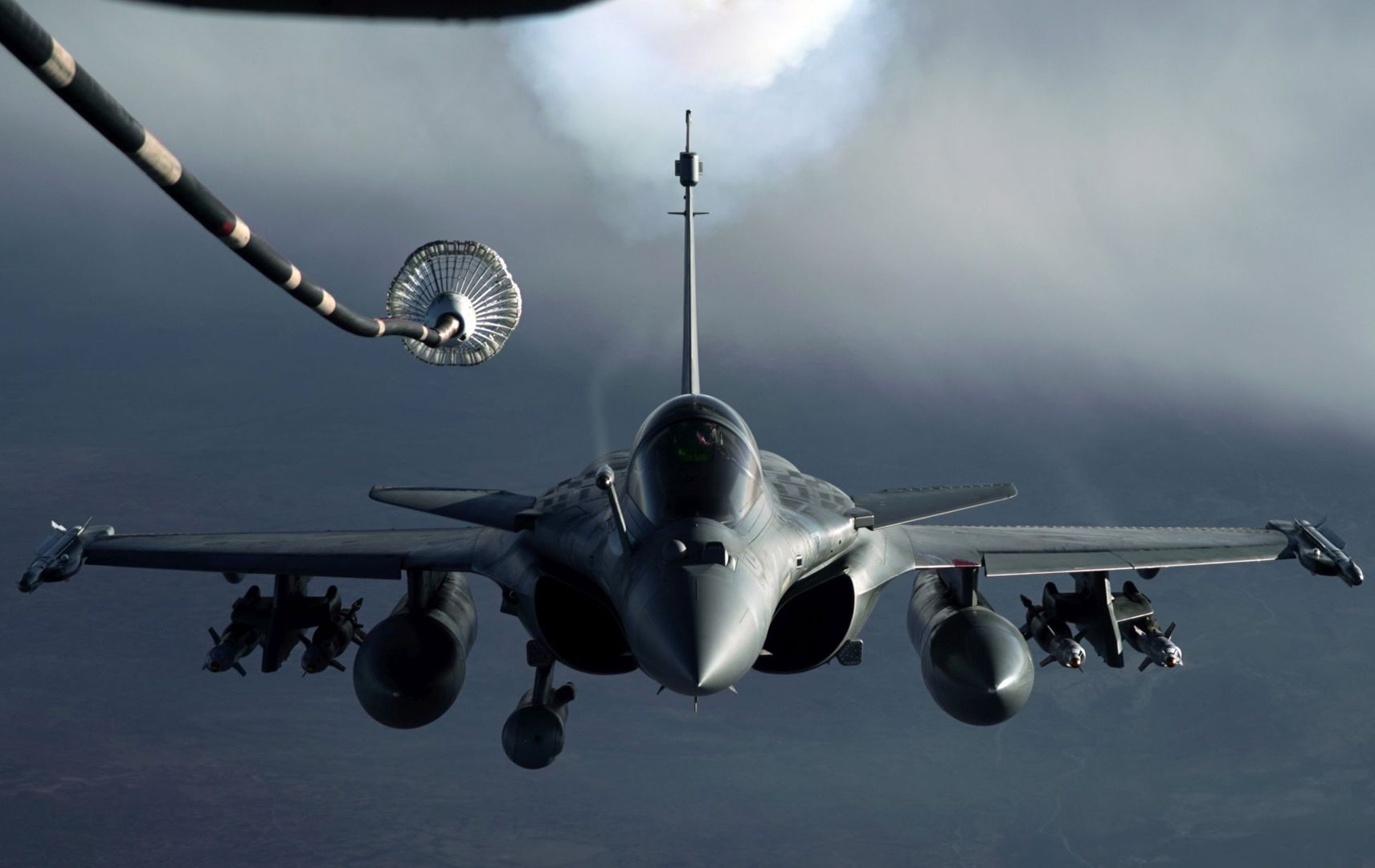
Croatia gets French fighter jets in major arms purchase

China warns US military support for Taiwan increases ‘risk of conflict’

UK aims to boost economic defences against security risks
Defense forum discussions.
- Royal Malaysian Navy (RMN) update
- The Russian-Ukrainian War Thread
- The Royal Navy Discussions and Updates
- Indonesia: 'green water navy'
- Indian Military Aviation; News, Updates & Discussions
- Australian Army Discussions and Updates
- Royal Australian Navy Discussions and Updates 2.0
- PRC Peoples Liberation Army Navy
- Russia - General Discussion.
- Military Aviation News and Discussion

© 2003-2020 DefenceTalk.com
Navigate Site
- Defence Forum
US Air Force Decides to Retire Advanced Cruise Missile
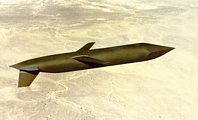
The U.S. Air Force has decided to retire the Advanced Cruise Missile, the most modern and capable nuclear cruise missile in the U.S. arsenal, according to information obtained by the Federation of American Scientists.
The decision affects approximately 400 ACMs (AGM-129A) currently deployed at Minot Air Force Base in North Dakota and Barksdale Air Force Base in Louisiana. Each missile carries a W80-1 warhead with a yield of 5-150 kilotons. The ACM is designed for delivery by B-52H strategic bombers.
FAS analyst Hans Kristensen noticed elimination of funding for the ACM in the Air Force’s FY2008 budget request, and a subsequent email to the Air Force confirmed the decision to retire the weapon system. The Air Force has not announced when the retirement will be completed, but it appears to be within the next year.
The decision to retire the ACM is part of the reduction of strategic nuclear warheads under the 2002 SORT agreement (Moscow Treaty), which limits U.S. and Russian operationally deployed strategic nuclear warheads to a maximum of 2,200 by 2012. To meet the treaty limit, the United States already has reduced the number of nuclear warheads on sea-launched ballistic missiles and is in the middle of a download of warheads from land-based ballistic missiles. Confirmation of the ACM retirement is the first public statement about a reduction of warheads on the bomber force.
The ACM is one of two nuclear cruise missiles in the U.S. arsenal, but the only nuclear cruise missile built with stealth technology to evade radar detection. The ACM, which has hard target kill capability, was produced by General Dynamics between 1987 and 1993. The initial plan was to produced nearly 1,500 missiles but the program was cut back to 460 missiles in 1991. The Air Force has not decided what to do with the retired ACM airframes, but is exploring alternative uses such as converting them to carry conventional warheads or use in missile tests.
The Air Force also has an inventory of approximately 1,300 older Air Launched Cruise Missiles (AGM-86B), which also carry the 80-1 warhead. The Air Launched Cruise Missile (ALCM) has just completed a life-extension program, and funding continues through 2013. It is estimated that the ALCM force will be reduced by two-thirds over the next five years.
The United States currently has total stockpile of nearly 9,900 nuclear warheads, of which roughly 4,700 are operationally deployed. Approximately 2,000 warheads are in the Responsive Force, a reserve of extra warheads available to increase the operational force if necessary. The remaining 3,000 warheads are scheduled to be dismantled. After the reductions under the SORT agreement are completed in 2012, the United States will still have a nuclear stockpile of nearly 6,000 warheads.
Background: Status of World Nuclear Forces
Unique social media images reveal the likely retirement of an old Indian nuclear-capable system.
The Federation of American Scientists applauds the United States for declassifying the number of nuclear warheads in its military stockpile and the number of retired and dismantled warheads.
North Korea may have produced enough fissile material to build up to 90 nuclear warheads.
Secretary Austin’s likely certification of the Sentinel program should be open to public interrogation, and Congress must thoroughly examine whether every requirement is met before allowing the program to continue.
Raytheon (General Dynamics) AGM-129 ACM
The AGM-129 ACM (Advanced Cruise Missile) is a stealthy, nuclear-armed cruise missile used exclusively by B-52H Stratofortress strategic bombers. It was originally planned to completely replace the AGM-86 ALCM , but limited funding led to the procurment of less than 500 missiles.
USAF studies for a new cruise missile with stealth characteristics began in 1982, when it became clear that the AGM-86 ALCM would become too easily detectable by future advanced air-defense systems. In 1983, General Dynamics was awarded the development contract for the new AGM-129A ACM . The first test missile flew in July 1985, and in June 1990, the first production missiles were delivered to the USAF.
The AGM-129A is powered by a Williams F112 turbofan engine, and armed with the same W-80-1 variable-yield thermonuclear warhead as the AGM-86B ALCM . Its external shape is optimized for LO (Low Observables) characteristics and includes forward-swept wings and tailplanes, a flush air intake, and a flat shielded jet exhaust. For guidance, the ACM uses an inertial navigation system together with a TERCOM (Terrain Contour Matching) system. The accuracy is quoted between 30 m (100 ft) and 90 m (300 ft), but it is highly likely, that the operational missiles were upgraded with GPS receivers for further enhanced accuracy. Range of the AGM-129A is also significantly higher than that of the AGM-86B. Alhough the ACM was originally intended for the B-1B, it is now deployed only by the B-52H. A cruise-missile configured B-52H can carry up to 20 ACMs , eight on the internal rotary launcher, and 12 on two underwing pylons.
Original plans called for the production of up to 2500 AGM-129 missiles, but this total was soon reduced to 1460 and later to 1000. Like many other weapon programs, the ACM was affected by the end of the Cold War. In 1992, the USAF announced to halt production of the missile after 460 rounds, and the last one was delivered in 1993. Current prime contractor for all AGM-129 activities is Raytheon Missile Systems Co.
There was also a projected AGM-129B version of the ACM . The official source [3] describes it as an "AGM-129A modified with structural and software changes and an alternate nuclear warhead for accomplishing a classified cruise missile mission." Apart from that, no further information is available, but most likely no ACMs were completed as AGM-129Bs. Reports, which attribute the AGM-129B designation to a planned, but eventually not funded, non-nuclear version of the ACM are erroneous. While a conventionally armed ACM was indeed proposed to the USAF by General Dynamics (and unofficially referred to as "AGM-129C"), this proposal was turned down.
In March 2007, the USAF announced that it will retire its entire stockpile of AGM-129 missiles (most likely until some time in 2008).
Specifications
Note: Data given by several sources show slight variations. Figures given below may therefore be inaccurate!
Data for AGM-129A :
Main Sources
[1] James N. Gibson: "Nuclear Weapons of the United States", Schiffer Publishing Ltd, 1996 [2] Hajime Ozu: "Missile 2000 - Reference Guide to World Missile Systems", Shinkigensha, 2000 [3] "DOD 4120.15-L: Model Designation of Military Aerospace Vehicles", Department of Defense, 1990
Back to Current Designations Of U.S. Unmanned Military Aerospace Vehicles Back to Directory of U.S. Military Rockets and Missiles
Aerospace Projects Review Blog
Stagger around #3: agm-129 “stealth” advanced cruise missile.
Literally years in the making, I’ve put together two versions of a photo essay of several surviving examples of the AGM-129 Advanced Cruise Missile. Available free for the downloading is Stagger Around #3: AGM-129 Advanced Cruise Missile, Abridged Edition as a 13 page PDF booklet . This contains photos of the AGM-129s on display at Hill Aerospace Museum in Utah, the USAF Museum in Dayton and the Strategic Air & Space Museum in Nebraska, ready to print.
Also available is Stagger Around #3: AGM-129 Advanced Cruise Missile, Full Edition . This 34-page edition includes more photos of these missiles, along with the missile at the San Diego Aerospace Museum restoration facility, a rare General Dynamics display model, official USAF photos of the AGM-129 in test and in service and drawings of the missile, including 1/32 scale layout diagrams. This is available through MagCloud , either as a downloadable PDF ($5.75) or as a professionally printed and bound edition ($11.80).
Don’t forget to check out my other MagCloud publications , including Justo Miranda’s Reichdreams Dossiers , Aerospace Projects Review , Historical Documents , and Photographing Stuff .
And don’t forget to check out Stagger Around #1, F-104A Starfighter , and Stagger Around #2, Starship Enterprise.
Leave a Reply Cancel reply
Your Comment
You may use these HTML tags and attributes: <a href="" title=""> <abbr title=""> <acronym title=""> <b> <blockquote cite=""> <cite> <code> <del datetime=""> <em> <i> <q cite=""> <s> <strike> <strong>
Name (required)
E-mail (required)
Save my name, email, and website in this browser for the next time I comment.
- Big Machines
AGM-129 ACM: The U.S. Stealth Cruise Missile

AGM-129 ACM
The AGM-129 ACM
The AGM-129 Advanced Cruise Missile (ACM) is an air-launched stealthy cruise missile developed by the United States.
You Might Also Like

Glide Bomb vs Cruise Missile: Understanding the Key Differences

Type 81: Japan’s Early Air Defense System

The Most Powerful Rockets

Sky Sabre: The UK’s Modern Air Defense
Origins and development, design and features, specifications, the asteroid’s close encounter with earth in 2029, why is the moon visible during the day, laura santiago.
Laura was born and raised in big town Atlanta, but eventually she got tired of the city dwelling lifestyle and decided to move to Georgia countryside. There with her husband she runs their car repair shop which has been going strong for 7 years now. She is a mother of two loving daughters and a dog mommy of the cutest pug Theodor. When she isn't working, Laura likes to write articles, as journalism is her big passion, as well as the field she majored in.
Related News

Explore the key differences between glide bombs and cruise missiles in terms of design, functionality, and deployment. Learn about their...

The Type 81 was an important early air defense system for Japan, providing mobile and effective air defense capabilities against...

Rockets have always fascinated mankind, symbolizing our urge to explore the unknown and push the boundaries of what is possible....

The United Kingdom has developed and deployed a cutting-edge air defense system known as Sky Sabre. This advanced system combines...

Nuclear War on Mars
Leave a reply cancel reply.
Your email address will not be published. Required fields are marked *
Save my name, email, and website in this browser for the next time I comment.
Trending News

US Navy Unmanned Surface Vessel Division One

From Battleships to Hybrid Warships

The Autonomous Vehicle Revolution
Uncover the inspiring world of colossal machines, from military behemoths to industrial titans, and the incredible stories behind their design and operation.
- Privacy Policy
- Coolinarco.com
- CasualSelf.com
- Fit.CasualSelf.com
- Sport.CasualSelf.com
- SportBeep.com
- EconomyLens.com
- MagnifyPost.com
- TodayAiNews.com
- VideosArena.com
© 2024 MachinaSphere.com ~ Inspiring world of colossal machines
© 2024 MachinaSphere.com ~ Inspiring world of colossal machines.

IMAGES
COMMENTS
The AGM-129 ACM (Advanced Cruise Missile) was a low-observable, subsonic, turbofan-powered, air-launched cruise missile originally designed and built by General Dynamics and eventually acquired by Raytheon Missile Systems.Prior to its withdrawal from service in 2012, the AGM-129A was carried exclusively by the US Air Force's B-52H Stratofortress bombers.
The AGM-129A is a subsonic, turbofan-powered, air-launched cruise missile. It is harder to detect, and has greater range and accuracy than the AGM-86 air-launched cruise missile. The ACM achieves maximum range through its highly efficient engine, aerodynamics and fuel loading. B-52H bombers can carry up to six AGM-129A missiles on each of two ...
The AGM-129A is a subsonic, turbofan-powered, air-launched cruise missile. It is harder to detect, and has greater range and accuracy than the AGM-86 air-launched cruise missile. The ACM achieves ...
In fact, the AGM-129 could be considered the second stealth aircraft to ever enter production, because that is what it really was, albeit one that was designed upside down, and for good reason. The origins of the ACM are fairly straightforward. The AGM-86B Air-Launched Cruise Missile (ALCM) entered service in the early 1980s.
The Convair/General Dynamics/Raytheon AGM-129A Advanced Cruise Missile was an air-launched, high-subsonic-capable missile developed for employment with Air Force manned bomber programs. The ACM was designed to supplement AGM-86B Air-Launched Cruise Missiles already in use and first flew in 1985. Initial deliveries to Air Force stocks took place ...
The AGM-129A is a subsonic, turbofan-powered, air-launched cruise missile. It is harder to detect, and has greater range and accuracy than the AGM-86 air-launched cruise missile. The ACM achieves maximum range through its highly efficient engine, aerodynamics and fuel loading. B-52H bombers can carry up to six AGM-129A missiles on each of two ...
The Advanced Cruise Missile (ACM) is an air-to-ground cruise missile developed to provide the U.S. Air Force with a long range, highly survivable, strategic standoff weapon. The ACM uses laser sensor updates to give it high navigation accuracy, and stealth technology gives it a low radar cross section and increased chance to penetrate enemy ...
The AGM-129A advanced cruise missile is a stealth, nuclear-capable cruise missile used exclusively by B-52H bombers. The AGM-129A is a subsonic, turbofan-powered, air-launched cruise missile. It is harder to detect, and has greater range and accuracy than the AGM-86 air-launched cruise missile. The ACM achieves maximum range through its highly ...
AGM-129A Advanced Cruise Missile. The AGM-129A was a subsonic, turbofan-powered, air-launched cruise missile. It was harder to detect and had greater range and accuracy than the AGM-86 Air-Launched Cruise Missile (ALCM). B-52 bombers could carry up to six AGM-129A missiles on each of two external pylons for a total of 12 per aircraft.
The Convair/General Dynamics/Raytheon AGM-129A Advanced Cruise Missile was an air-launched, high-subsonic capable missile developed for employment with Air Force manned bomber programs. The ACM ...
The AGM-129 ACM is a subsonic air-launched cruise missile used primarily by the United States Air Force. Featuring a length of 4.5 meters and a wingspan of 2.7 meters, this missile boasts a formidable range exceeding 2,000 kilometers. Its 2-stage jet engine propels it at speeds capable of penetrating enemy defenses effectively.
The AGM-129 ACM was a stealthy air-launched cruise missile designed to evade advanced air defenses. It was retired in 2012 as part of the U.S. effort to redu...
The AGM-129A was an air-to-ground stealth cruise missile capable of carrying a nuclear or conventional warhead. Its story began in 1982 when the U.S. Air Force determined that Soviet air defenses ...
The AGM-129A advanced cruise missile is a stealth, nuclear-capable cruise missile used exclusively by B-52H bombers. The AGM-129A is a subsonic, turbofan-powered, air-launched cruise missile. It is harder to detect, and has greater range and accuracy than the AGM-86 air-launched cruise missile. The ACM achieves maximum range through its highly ...
The U.S. Air Force has decided to retire the Advanced Cruise Missile, the most modern and capable nuclear cruise missile in the U.S. arsenal, according to information obtained by the Federation of American Scientists. The decision affects approximately 400 ACMs (AGM-129A) currently deployed at Minot Air Force Base in North Dakota and Barksdale Air Force […]
ACM. The AGM-129 ACM (Advanced Cruise Missile) is a stealthy, nuclear-armed cruise missile used exclusively by B-52H Stratofortress strategic bombers. It was originally planned to completely replace the AGM-86 ALCM , but limited funding led to the procurment of less than 500 missiles. USAF studies for a new cruise missile with stealth ...
This contains photos of the AGM-129s on display at Hill Aerospace Museum in Utah, the USAF Museum in Dayton and the Strategic Air & Space Museum in Nebraska, ready to print. Also available is Stagger Around #3: AGM-129 Advanced Cruise Missile, Full Edition. This 34-page edition includes more photos of these missiles, along with the missile at ...
The AGM-129 ACM. The AGM-129 Advanced Cruise Missile (ACM) is an air-launched stealthy cruise missile developed by the United States. You Might Also Like. Type 81: Japan's Early Air Defense System. June 20, 2024. 840 . The Most Powerful Rockets. June 12, 2024. 620 . Sky Sabre: The UK's Modern Air Defense.
April 26, 2012. Without fanfare, an excavator recently severed the fuselage of the Air Force's last AGM-129A Advanced Cruise Missile during a ceremony at Hill AFB, Utah. Destruction of this AGM-129 completed the demilitarization of this cruise missile type and associated trainers, components, and engines "within budget and ahead of schedule ...
The Raytheon AGM-129 ACM (Advanced Cruise Missile) is a low observable, sub-sonic, turbo-fan powered, air-launched cruise missile built by Raytheon Missile S...
On 29 August 2007, six AGM-129 ACM cruise missiles, each loaded with a W80-1 variable yield nuclear warhead, were mistakenly loaded onto a United States Air Force (USAF) B-52H heavy bomber at Minot Air Force Base in North Dakota and transported to Barksdale Air Force Base in Louisiana.The nuclear warheads in the missiles were supposed to have been removed before the missiles were taken from ...
AGM-129 ACM being secured on a B-52H bomber. The most common mission for cruise missiles is to attack relatively high-value targets such as ships, command bunkers, bridges and dams. [52] Modern guidance systems permit accurate attacks. As of 2001, the BGM-109 Tomahawk missile model has become a significant part of the United States naval ...
AGM-129 ACM (англ. AGM-129 Advanced Cruise Missile) — высокоточная стратегическая крылатая ракета класса «воздух — поверхность», разработана фирмой General Dynamics в США. Работы по программе ACM (Advanced Cruise Missile) были ...